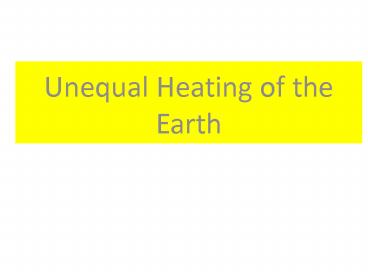Unequal Heating of the Earth - PowerPoint PPT Presentation
1 / 27
Title:
Unequal Heating of the Earth
Description:
This affects land/sea breezes Both sea and land breezes are caused by unequal heating of Earth ... GLOBAL WIND BELTS Global winds are named based off of where they ... – PowerPoint PPT presentation
Number of Views:1552
Avg rating:3.0/5.0
Title: Unequal Heating of the Earth
1
- Unequal Heating of the Earth
2
Heating the Earth
- The sun heats air, land water BUT air, water,
and land get heated differently. - The sun heats all areas of the Earth BUT
different areas of the world get heated
differently
3
The Sun
- The most important source of energy for the Earth
4
So whose getting the most Sun?
- Areas around the equator get more sun than areas
near the North and South Pole - Small degrees of latitude (0 30 degrees) get
more sun
5
3 ways that heat can be transferred
- The sun can heat things in 3 different ways.
6
Conduction
- Happens when two objects of different
temperatures are touching each other - Heat travels from the warmer object to the cooler
object - Examples touching a stove and being burned, ice
cooling down in your hand
7
Radiation
- Happens when the heat energy from one object is
transferred directly to another (not through
contact, or through a liquid or a gas) - Examples warmth of the Sun, a campfire, or an
open oven door, heat from a light bulb
8
Convection
- Happens when warmer areas of a liquid or gas rise
to cooler areas in the liquid or gas and then
come back down when they get colder. - Creates a circle, because of density differences
- Example convection currents, water boiling in
circles in a pot, old heaters
9
Inquiry Heat Lab
- Research question If we measure the temperature
of soil/sand and water when it is heated by
radiation, which one will absorb and lose heat
fastest? - Background Research
- Earth materials the naturally occurring
materials found on Earth (water, air, soil,
sand). - Lab Safety DO NOT TOUCH THE HEAT LAMP!
10
Lab Description
- We will place different materials in small cups,
place a thermometer in them, and use heat lamps
to represent the suns radiation. - We will record the temperature every 2 minutes
for 20 minutes. After 10 minutes we will turn off
the heat lamps. - Group members will rotate measuring the
temperature of each material. - You will record the temperature on your own data
collection sheet and share your data with your
team between the 2 minute intervals.
11
Lab Expectations
- We will work in groups of 4-7.
- We will measure temperatures silently and raise
our hands with any questions. - We will stay focused only on the lab.
- After data collectedyou will find your number
match and work together to fill in your other
table, to graph and to answer post lab sheet.
LAB SAFETY DO NOT TOUCH THE HEAT LAMP!
12
Post lab What do you think?!
- What energy source heats things up during the
day? - Do you think the surface of Earth affects how hot
the air gets?
13
Heat Capacity
- The amount of heat required to change the
temperature of the matter. - Which means How much heat does the object need
to absorb in order to actually warm upthe LONGER
the object takes to change temperature the
GREATER THE HEAT CAPACITY. - Critical Thinking Which had the greater heat
capacitysand or water? THINK PAIR SHARE
14
Application/ Check for understanding
- Which heats up fastertoast or coffee?
- Which stays hot longertoast or coffee?
15
Differential (unequal) heating of land vs. water?
- Land heats up faster than water and cools down
faster than water - The air above land is much warmer than the air
above waterland transfers heat to air faster and
more frequently (conduction)
16
Differential (unequal) heating of land vs. water?
- Water heats up more slowly and cools down more
slowly - It has a greater heat capacity
17
Wind
- Wind is the horizontal movement of air from an
area of high pressure to an area of lower
pressure. - Wind is caused from the unequal heating of the
earth - What causes areas of the earth to be heated more
or less? - Suns Energy!
18
Which type of heat transfer causes wind?
- Radiation Suns radiation will hit earth at
different angles (directly/90 degrees or
indirectly/30 degrees) - Convection Warm air rises, cold air sinks this
causes the air to move - Conduction Land loses and gains heat quickly,
water loses and gains heat slowly. This affects
land/sea breezes
19
Local winds are winds that travel over short
distances.
- Both sea and land breezes are caused by unequal
heating of Earths surface.
20
(No Transcript)
21
In Summary
22
Group Work Challenge from Homework
23
Global Wind Belts (Part 2)
24
GLOBAL WINDS
- Global winds are created by the unequal heating
of Earths surface.
25
GLOBAL WIND BELTS
Global winds are named based off of where they
COME FROM!
26
GLOBAL WINDS
- Global winds are an example of CONVECTION because
heat is circulated around the globe by the
movement of a fluid (AIR!).
27
CORIOLIS EFFECT































